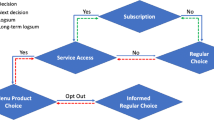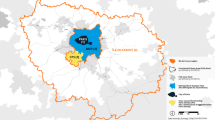Abstract
The evaluation of pricing approaches for mobile data services proposed in the literature can rarely be done in practice. Evaluation by simulation is the most common practice. In these proposals demand and utility functions that describe the reaction of users to offered service prices, use traditional and arbitrary functions (linear, exponential, logit, etc.). In this paper, we present a new approach to construct a simulation model whose output can be used as an alternative method to create demand functions avoiding to use arbitrary and predefined demand functions. However, it is out of the scope of this paper to utilize them to propose pricing approaches, since the main objective of this article is to show the difference between the arbitrary demand functions used and our approach that come from users’ data. The starting point in this paper is to consider data offered from Eurostat, although other data sources could be used for the same purposes with the aim to offer more realistic values that could characterize more appropriately, what users are demanding. In this sense, some demographic and psychographic characteristics of the users are included and others such as the utilization of application usage profiles, as parameters that are included in the user`s profiles. These characteristics and usage profiles make up the user profile that will influence users’ behavior in the model. Using the same procedure, Mobile Network Operators could feed their customers’ data into the model and use it to validate their pricing approaches more accurately before their real implementation or simulate future or hypothetical scenarios. It also makes possible to segment users and make insights for decision-making. Results presented in this paper refer to a simple study case, since the purpose of the paper is to show how the proposal model works and to reveal its differences with arbitrary demand functions used. Of course, results depend on the set of parameters assigned to characterize each user’s profile.













Similar content being viewed by others
References
Garnaev, A., Yezekael, H., Avrachenkov, K., Altman, E.: Throughput and QoS pricing in wireless communication. In: Proceedings of the 5th International ICST Conference on Performance Evaluation Methodologies and Tools (2011)
Loiseau, P, Schwartz, G., Amin, S., Sastry, S.S.: Congestion pricing using a raffle-based scheme. In: Proceedings of Network Games, Control and Optimization, no. 2, pp. 1–8 (2011)
Nabipay, P., Odlyzko, A., Zhang, Z.: Flat versus metered rates, bundling, and “bandwidth hogs”. In: Proceedings of the 6th Workshop on the Economics of Networks, Systems, and Computation (NetEcon11) (2011)
Al-Manthari, B., Nasser, N., Hassanein, H.: Congestion pricing in wireless cellular networks. IEEE Commun. Surv. Tutor. 13(3), 358–371 (2011)
Chen, Q.-B., Zhou, W.-G., Chai, R., Tang, L.: Game-theoretic approach for pricing strategy and network selection in heterogeneous wireless networks. IET Commun. 5(5), 676–682 (2011)
Chen, Y.F., Jana, R., Kannan, K.N.: Using generalized second price auction for congestion pricing. In: GLOBECOM-IEEE Global Telecommunications Conference, pp. 1–6 (2011)
Giacomazzi, P., Stanojev, I., Verticale, G.: A negotiation-based scheme for service level pricing for wireless access. Comput. Commun. 35(4), 444–453 (2012)
Guerrero-Ibáez, A., Contreras-Castillo, J., Barba, A., Reyes, A.: A QoS-based dynamic pricing approach for services provisioning in heterogeneous wireless access networks. Pervasive Mob. Comput. 7(5), 569–583 (2011)
Gabriel Gussen, C.M., Belmega, E.V., Debbah, M.: Pricing and bandwidth allocation problems in wireless multi-tier networks. In: Conference Record-Asilomar Conference on Signals, Systems and Computers, pp. 1633–1637 (2011)
Lai, C., Yang, Y., Wang, L., Wang, X.: A new pricing mechanism for power control in multicell wireless data networks. In: IEEE International Conference on Control and Automation, ICCA, pp. 1879–1883 (2013)
Lai, C., Yang, Y., Wang, L., Wang, X.: Power control based on improved pricing mechanism in a CDMA network. J. Comput. Inf. Syst. 8(2), 8373–8380 (2012)
Lee, D., Mo, J., Walrand, J., Park, J.: A token pricing scheme for internet services. In: Cohen, J., Maillé, P., Stiller, Burkhard (eds.) ICQT 2011. LNCS, vol. 6995, pp. 26–37. Springer, Heidelberg (2011)
Ren, S., Park, J., Van Der Schaar, M.: Entry and spectrum sharing scheme selection in femtocell communications markets. IEEE/ACM Trans. Netw. 21(1), 218–232 (2013)
Ren, S., Van Der Schaar, M.: Pricing and distributed power control in wireless relay networks. IEEE Trans. Signal Process. 59(6), 2913–2926 (2011)
Song, Y., Zhang, C., Fang, Y., Lin, P.: Revenue maximization in time-varying multi-hop wireless networks: a dynamic pricing approach. IEEE J. Sel. Areas Commun. 30(7), 1237–1245 (2012)
Parris, C., Keshav, S., Ferrari, D.: A framework for the study of pricing in integrated networks. International Computer Science Institute, Berkeley, CA (1992)
Al-Manthari, B., Nasser, N., Ali, N.A., Hassanein, H.: Congestion prevention in broadband wireless access systems: an economic approach. J. Netw. Comput. Appl. 34(6), 1836–1847 (2011)
Eurostat: Browse statistics by theme—Eurostat. http://ec.europa.eu/eurostat/data/browse-statistics-by-theme. Accessed 09 Jan 2018
Sandvine: Global internet phenomena report 1 h 2014 (2014)
Roberts, M.: Understanding today’s smartphone user: an updated and expanded analysis of data-usage patterns in six of the world’s most advanced 4G LTE markets. London (2013)
Talluri, K.T., Van Ryzin, G.J.: Customer-behavior and market-response models. In: The Theory and Practice of Revenue Management, pp. 301–331, Springer, Boston, MA (2004)
Ha, S., Sen, S., Joe-Wong, C., Im, Y., Chiang, M.: TUBE: time-dependent pricing for mobile data. In: Proceedings of the ACM SIGCOMM 2012 Conference on Applications, Technologies, Architectures, and Protocols for Computer Communication—SIGCOMM’12, pp. 247–258 (2012)
Assimakopoulos, C.: Mobile internet users profile along with subscribers model of payment and attitudinal characteristics. Procedia Technol. 8, 425–434 (2013)
Ernst & Young Global Limited: “The mobile maze: navigating the mobile maze,” 2013. http://www.ey.com/gl/en/industries/telecommunications/the-mobile-maze_navigating-the-mobile-maze. Accessed 09 Jan2018
Kumar, U., Helmy, A.: Extract: mining social features from WLAN traces: a gender-based case study. In: Proceedings of the 13th ACM International Conference on Modeling, Analysis, and Simulation of Wireless and Mobile Systems, pp. 240–247 (2010)
Morris, M.G., Venkatesh, V.: Age differences in technology adoption decision: implications for a changing work force. Pers. Psychol. 53(2), 375–403 (2000)
Pagani, M.: Determinants of adoption of third generation mobile multimedia services. J. Interact. Mark. 18(3), 46–59 (2004)
Papaioannou, E., Georgiadis, C., Kourouthanassis, P., Giaglis, G.: Profiling the mobile phone users and their relationship to the internet services and portals. In: 10th International Conference on Mobile Business, pp. 313–319 (2011)
Peslak, A., Shannon, L.-J., Ceccucci, W.: An empirical study of cell phone and smartphone usage. Issues Inf. Syst. 12(1), 407–417 (2011)
Quorus Consulting Group: 2012 Cell phone consumer attitudes study (2012)
Shi, C.K., Hao, X., Sharma, R.S.: A cross-disciplinary study of what determines the adoption of MDS. In: Proceedings of the Annual Hawaii International Conference on System Sciences, pp. 1–11 (2010)
Sell, A., Mezei, J., Walden, P.: An attitude-based latent class segmentation analysis of mobile phone users. Telemat. Inform. 31(2), 209–219 (2014)
Im, I., Hong, S., Kang, M.S.: An international comparison of technology adoption: testing the UTAUT model. Inf. Manag. 48(1), 1–8 (2011)
Rocha, E., Salvador, P., Nogueira, A.: Classification of hidden users’ profiles in wireless communications. In: Pentikousis, K., Aguiar, R., Sargento, S., Agüero, R. (eds.) Mobile Networks and Management: Third International ICST Conference, MONAMI 2011, Aveiro, Portugal, September 21–23, 2011, Revised Selected Papers, pp. 3–16. Springer Berlin Heidelberg, Berlin, Heidelberg (2012)
Dewey, J.: How we think. Dover Publications, Mineola (1910)
OpenSim Ltd. “OMNeT ++ Discrete Event Simulator—Home.” https://omnetpp.org/. Accessed 09 Jan 2018
Bemmaor, A.C., Glady, N.: Modeling purchasing behavior with sudden ‘death’: a flexible customer lifetime model. Manag. Sci. 58(5), 1012–1021 (2012)
MathWorks, “MATLAB.” https://www.mathworks.com/products/matlab.html. Accessed 09 Jan 2018
Hutchinson 3G UK Ltd.: How much data do I need? | Data calculator—Three (2018). http://www.three.co.uk/datacalculator. Accessed 09 Jan 2018
Verizon Wireless: Household data usage calculator (2018). https://www.verizonwireless.com/freedom/datacalculator.html. Accessed 09 Jan 2018
Acknowledgements
We want to acknowledge Mario Flores-Mendez for his help in the elaboration of this work. This work is partly supported by Project TEC2015-71329-C2-2-R (MINECO/FEDER) of the Ministerio de Economia y Competitividad.
Author information
Authors and Affiliations
Corresponding author
Rights and permissions
About this article
Cite this article
Postigo-Boix, M., Melús-Moreno, J.L. Generating Demand Functions for Data Plans from Mobile Network Operators Based on Users’ Profiles. J Netw Syst Manage 26, 904–928 (2018). https://doi.org/10.1007/s10922-018-9448-1
Received:
Revised:
Accepted:
Published:
Issue Date:
DOI: https://doi.org/10.1007/s10922-018-9448-1




